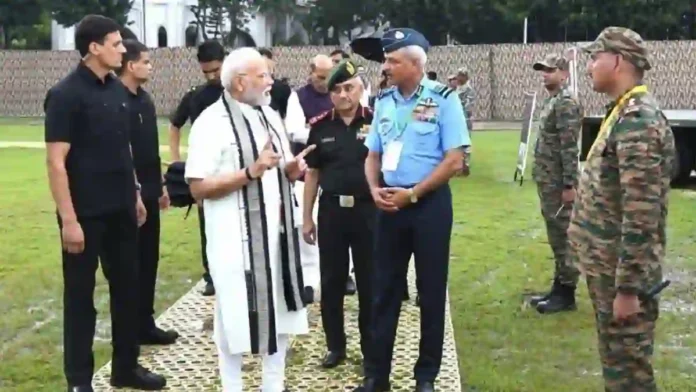Prime Minister Narendra Modi on Monday unveiled the “Indian Armed Forces Vision 2047” document during the 16th edition of the Combined Commanders’ Conference in Calcutta, marking a major step towards shaping India’s long-term military doctrine.
The unveiling took place at Vijay Durg (formerly Fort William), headquarters of the Army’s Eastern Command, underscoring the historical symbolism of the venue and its role in India’s defence evolution.
Read- Union Home Ministry To Set Up Jungle Warfare School In Red Corridor
The Vision 2047 document, described by senior military officials as a forward-looking war doctrine, focuses on making the Indian military an all-domain, technology-powered force.
It outlines the integration of emerging technologies such as artificial intelligence, cyber warfare capabilities, space-based assets, and data-driven decision-making systems into the armed forces’ operational framework. The doctrine’s central theme is an integrated and networked approach to modern warfare, aiming to synergise the Army, Navy, Air Force, and newly developing cyber and space commands.
In his address to the top brass, Modi highlighted the military’s contribution to nation-building as well as its role in securing India’s strategic interests amid turbulent geopolitics and post-Operation Sindoor realities.
He reviewed progress achieved over the past two years, including reforms under the Chief of Defence Staff and the Integrated Theatre Commands plan, and stressed aligning future reforms with the next 25 years of India’s strategic trajectory.
Read- India Issues NOTAM For A Likely Missile Test In Bay of Bengal Region
Read- Attempts To Break India-Russia Ties Destined To Fail: Moscow Amid Trump Pressure
The conference, which convenes after a two-year gap since the 2023 edition in Bhopal, is being attended by Defence Minister Rajnath Singh, NSA Ajit Doval, CDS Gen. Anil Chauhan, Defence Secretary Rajesh Kumar Singh, service chiefs, senior commanders, and officials from multiple ministries. This cross-sector presence reflects a whole-of-government approach to national security, bridging the civil-military decision-making gap.
Sessions at the three-day forum are focused on transformational reforms, structural and administrative adaptations, and operational preparedness, including lessons from recent conflicts worldwide and joint force performance during Operation Sindoor.
The agenda includes reviewing new command structures, indigenous defence production integration, and the roadmap for transitioning into a seamlessly joint, tech-enabled, and future-ready force.
Officials describe the Combined Commanders’ Conference as the apex strategic brainstorming forum, where military leadership interacts with the highest levels of political authority to align on threats, technology induction, and strategic priorities.
Over the next two days, participants will deliberate on feedback collected from the services, assess readiness amid global uncertainties, and map a phased plan to achieve the Vision 2047 transformation while keeping India’s strategic autonomy and deterrence capacity at the core.
Agencies




